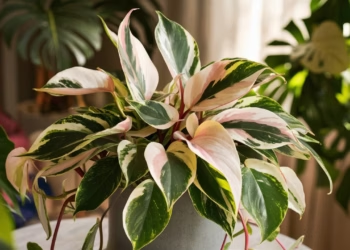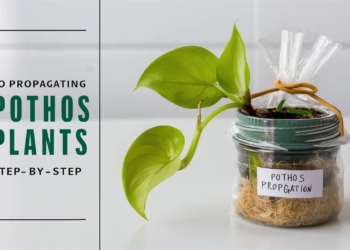So, you’ve decided to bring a touch of the tropics into your home with a beautiful sago palm, also known as Cycas Revoluta. Excellent choice! These majestic plants can add a dash of exotic elegance to any indoor space. But hold your horses! Before you go digging in the dirt, let’s delve into the world of sago palm indoor care – How to Grow Cycas Revoluta Indoors!
Table Of Contents
Getting to Know Your Sago Palm
Before we dive into the nitty-gritty of sago palm indoor care – How to Grow Cycas Revoluta Indoors, let’s take a moment to get acquainted with this striking plant.
- A Brief Introduction: The sago palm, despite its name, isn’t a true palm but rather a member of the ancient Cycad family.
- Appearance: With its glossy, feather-like fronds and stout trunk, the sago palm exudes a prehistoric charm that’s hard to resist.
- Origin: Native to Japan, the sago palm thrives in warm, subtropical climates but can adapt surprisingly well to indoor environments.
Lighting Requirements
Ah, lighting – the cornerstone of sago palm indoor care! Get this wrong, and your palm might not be living its best life.
Bright, Indirect Light: A Sago’s Delight
- Ideal Conditions: Position your sago palm in a spot that receives bright, indirect sunlight. Think of it as giving your plant a sunbath without the risk of sunburn!
- Avoid Direct Sunlight: While sago palms love light, direct sunlight can scorch their delicate fronds. So, keep them away from blazing windowsills!
- Shade Tolerance: Don’t fret if your home lacks ample sunlight – sago palms can tolerate moderate shade, but be sure to provide them with some natural light to keep them happy.

Watering Wisdom
Water, the elixir of life! But how much is too much when it comes to How to Grow Cycas Revoluta Indoors?
Moist, Not Drenched
- Moderation is Key: Water your sago palm thoroughly, allowing excess water to drain away. But remember, soggy soil is a no-go! Aim for moist, well-draining soil instead.
- Check Before You Soak: Before reaching for that watering can, stick your finger into the soil. If it feels dry about an inch below the surface, it’s time to give your palm a drink.
- Seasonal Adjustments: Adjust your watering schedule based on the season. In winter, sago palms enter a dormant phase and require less water, while in summer, they may need a bit more hydration to beat the heat.

Temperature and Humidity
What’s the perfect climate for your sago palm’s indoor adventure? Let’s find out!
Comfortable Temperatures
- Warmth Lover: Sago palms thrive in temperatures between 65°F to 80°F (18°C to 27°C). Keep them cozy, and they’ll reward you with lush, green foliage!
- Winter Chill: While sago palms can tolerate cooler temperatures, avoid exposing them to frosty drafts or sudden temperature drops. Brr, nobody likes cold feet – including your palm!
- Humidity Hacks: Boost humidity levels by misting your sago palm occasionally or placing a tray of water near its pot. Remember, a little humidity goes a long way in keeping your palm perky!

Fertilizing Fundamentals
To feed or not to feed? That is the question when it comes to sago palm indoor care!
Feed Me, Seymour!
- Feeding Schedule: During the growing season (spring and summer), fertilize your sago palm every 4-6 weeks with a balanced, water-soluble fertilizer diluted to half strength.
- Easy Does It: Avoid over-fertilizing, as this can lead to fertilizer burn and damage your palm’s roots. Remember, moderation is key!
- Winter Hiatus: In winter, give your sago palm a break from fertilization. Think of it as a well-deserved vacation for your hardworking plant!

Common Issues and Troubleshooting
Uh-oh, is your sago palm feeling under the weather? Let’s diagnose and treat those pesky problems!
Toxicity Concerns
- Safety Precautions: Sago Palms contain toxins that can be harmful if ingested by pets or humans. Exercise caution and keep these plants out of reach of curious children and animals to prevent accidental ingestion.
Additional Care Tips
- Root Rot Prevention: Be mindful of overwatering, especially during the fall and winter months when Sago Palms are more susceptible to root rot. Allow the soil to dry out slightly between watering sessions to maintain optimal root health.
- Leaf Maintenance: As your Sago Palm matures, it will naturally shed its lower leaves. Trim yellowing or dead leaves close to the stem using sanitized pruning shears to promote overall plant vitality and aesthetics.
Yellowing Fronds: A Cry for Help
- Overwatering Alert: Yellow or droopy fronds could signal overwatering. Check the soil moisture and adjust your watering routine accordingly.
- Light Hunger: Insufficient light can also cause yellowing or stunted growth. Consider relocating your palm to a brighter spot to see if it perks up.
- Pest Patrol: Keep an eye out for common pests like scale insects or spider mites, especially if your sago palm’s foliage starts looking lackluster. A gentle wipe-down with soapy water can help banish these unwanted guests!

And there you have it – the ultimate guide to sago palm indoor care With the right mix of light, water, and TLC, your sago palm will thrive and bring a slice of tropical paradise right into your home. So, roll up your sleeves, get your green thumbs ready, and let the indoor jungle adventure begin!
FAQs
Do sago palms do well indoors?
Sago palms can thrive indoors if provided with the right conditions. They require bright, indirect sunlight and well-drained soil. While they can tolerate some direct sunlight, it’s best to avoid intense, prolonged exposure. Proper watering and occasional fertilization can also promote healthy growth.
How often should I water my Sago Palm indoors?
Watering frequency for indoor sago palms depends on factors like temperature, humidity, and soil moisture. Generally, allow the soil to dry slightly between waterings, and then thoroughly water the plant. In winter, reduce watering when the plant is less actively growing .
Do sago palms need direct sunlight?
Sago palms prefer bright, indirect sunlight, although they can tolerate some direct sun exposure on their foliage, especially in cooler climates. However, in hotter regions, it’s best to provide them with partial shade to prevent leaf burn .
Where should I place my Sago Palm indoors?
Place your Sago Palm indoors in a location that receives bright, indirect sunlight, such as near a window with sheer curtains. Avoid placing it in direct sunlight or in drafty areas. A well-ventilated room with stable temperatures is ideal.
Do sago palms clean the air?
Sago palms are not typically known for their air-purifying abilities. While all plants contribute somewhat to indoor air quality by absorbing carbon dioxide and releasing oxygen, sago palms are primarily valued for their ornamental appearance rather than their air-cleaning properties.
Is it okay to touch a Sago Palm?
It’s generally safe to touch a Sago Palm, but caution should be exercised around the plant. Sago palms contain toxins, including cycasin, which can be harmful if ingested. While touching the plant is unlikely to cause harm, it’s essential to wash your hands thoroughly afterward and avoid contact with your face or mouth.










